• New York City’s AEDT law reshapes how staffing vendors manage AI-driven hiring tools.
• Vendors are now directly accountable: annual bias audits, public summaries, and candidate notices are no longer optional.
• Compliance isn’t about ripping out your ATS, it’s about knowing what data to capture, when to send notices, and how to keep records audit-ready.
• The data pack auditors expect the notice system you need to build, the due-diligence checklist clients will demand, and a quarterly cadence that keeps compliance light but defensible.
• The blog flags easy-to-miss edge cases and outline a week-by-week playbook so vendors can stay compliant, reduce AI bias risk, and maintain client confidence.
In the modern staffing stack, automated decision-making is no longer optional, it underpins sourcing, ranking, screening, and scheduling. Whether it’s resume-scoring or assessment ranking, staffing and recruitment services vendors regularly deploy recruitment process tools that feed into hiring pipelines. Now, regulators are watching.
In New York City, the Automated Employment Decision Tools (AEDT) law, or Local Law 144, holds both employers and employment agencies are responsible for using AI tools in NYC-linked hiring. That means annual bias audits, publicly posted summaries, and candidate notices, all while preserving the integrity of your ATS.
For staffing partners, the stakes are clear: you are classified as an employment agency, which places you squarely within the law’s reach. The task is not to rip apart your ATS. It’s to ensure you can supply clean, audit-ready evidence and deliver required notices on time without disrupting hiring operations.
In this blog, we’ll map out what AEDT recruitment means in practice for staffing partners: the data your ATS must export, how to weave in candidate notices, what your vendor due diligence checklist must cover, and a lightweight quarterly audit cadence that keeps you compliant without derailing operations.
Why the NYC AEDT Law Matters for Vendors
New York City’s Automated Employment Decision Tools (AEDT) law often called Local Law 144 is one of the first binding regulations in the U.S. to address how AI and recruitment process tools shape hiring decisions. It came into effect in 2023 and is now fully enforced. The law requires any employer or employment agency that uses an automated system to screen or rank candidates for NYC-linked roles to meet three baseline obligations: conduct an independent bias audit every year, publish a summary of the results online, and issue clear advance notices to candidates.
At its core, the law isn’t trying to ban automation. It’s recognizing that AI-driven recruitment carries real risk of AI bias, skewed outcomes across gender, race, or ethnicity and making sure that those who use these tools have data to prove they aren’t discriminating. This is where staffing vendors must pause. You may think of compliance as your client’s responsibility, but the law explicitly includes employment agencies in its scope. If your team runs screening, resume ranking, or assessment scoring for an NYC-bound role, you are considered a user of an AEDT.
The triggers for coverage are broad. It’s not limited to a final hiring decision. If your tool “substantially assists or replaces” human judgment at any stage of the funnel from automated resume screening to a chatbot that pre-qualifies applicants, it qualifies. Even fully remote jobs are in scope if they are tied back to a New York City office.
For staffing vendors, this translates into very practical consequences. You must:
- Supply clean, auditable data exports from your ATS or other systems so an independent auditor can calculate selection and scoring rates.
- Ensure candidate notices go out at least 10 business days before an AEDT is applied.
- Help your clients post and maintain their public audit summaries, which must include the date, data source, and impact ratios across protected groups.
Failure to do so comes with escalating penalties. A first violation can cost $500, and subsequent violations can climb to $1,500 each. The catch: every day of unlawful use counts separately, and each missed notice is its own violation. In practice, this means liability can compound quickly if compliance is treated as an afterthought.
This is why vendors must care. Beyond statutory fines, reputational risk is mounting. The EEOC has stepped up its enforcement posture around AI bias in hiring, and discrimination charges tied to recruitment technology are growing. Add to that the scrutiny from courts, regulators, and clients’ recent cases involving major HR tech providers show that staffing vendor management is no longer a back-office detail. You’re expected to be audit-ready, explainable, and disciplined in how your AEDT recruitment processes run.
In short, Local Law 144 sets the floor. Staffing vendors that support NYC roles need to treat it as a client-facing promise: your ATS workflows stay intact, but the data and notices you generate are audit-proof. The next sections of this guide will break down exactly how to make that happen starting with the data pack auditors expect to see, and the notice logic you should embed directly into your recruitment process tools.
Building the Audit-Ready Data Pack and Candidate Notice System
For staffing vendors, the core of AEDT recruitment compliance isn’t about overhauling your technology. It’s about discipline and making sure the right data is captured, and the right notices are sent, on a predictable cadence. When an independent auditor comes knocking, or when a regulator reviews your records, your ability to supply a complete, traceable file will determine whether you’re compliant.
What Auditors Actually Need
Bias audits hinge on one thing: the ability to calculate selection and scoring rates across demographic groups. That means your ATS, or recruitment process tools should be able to produce a consistent export with the following:
- Requisition data: Requisition ID, role title, job family, location (with a flag for NYC-linked positions), posting and close dates.
- Candidate data: Pseudonymized candidate ID, application date, and movement across stages.
- Tool outputs: The scores, ranks, flags, or recommendations generated by the automated decision-making system.
- Final decisions: Advance, hold, reject, offer, accept markers, to show how tool output linked to outcomes.
- Demographics: Self-reported EEO-1 categories for sex and race/ethnicity, with “unknown” tracked separately.
- Audit context: Version numbers of the tools used, retraining dates, or changes in scoring rules.
This isn’t optional metadata. Without it, auditors can’t calculate impact ratios. And without ratios, your audit summary risks being incomplete leading to a violation under the NYC AEDT law.
Notices Without Friction
Equally important is the notice system. The law requires candidates for NYC roles to receive 10 business days’ advance notice before an AEDT is used. That notice must:
- State clearly that an automated tool will be used in the evaluation.
- Explain what qualifications or characteristics the tool will assess.
- Provide a link to the public bias audit summary.
- Offer a way to request an alternative process or reasonable accommodation.
- Disclose, or make available upon request, information on the type of data collected, its sources, and retention policies.
The simplest way to operationalize this is to embed notice triggers directly into your ATS. When a recruiter opens a requisition tagged as NYC or adds a candidate to a covered role, a notice template should automatically populate into the job posting or candidate communication flow. This ensures notices are consistent, timely, and logged for compliance.
When vendors fail here, it’s rarely intentional, it’s a gap in workflow. Notices get skipped when they rely on recruiters remembering to send them manually. By automating the trigger, you protect yourself and your clients from violations that can pile up daily.
Stay compliant,keep hiring on track with VBeyond
The Vendor Due-Diligence Checklist
Bias-audit readiness isn’t just about what your ATS can export. It’s about the ecosystem of tools and processes you touch as a staffing partner. Clients expect you to validate every automated step that influences their funnel. The safest way to do that is with a repeatable due-diligence checklist you can apply whenever you onboard a new client, adopt a new recruitment process tool, or refresh your compliance protocols.
1. Inventory Every Automated Tool
Begin by mapping the stack. Identify each system that “substantially assists” in hiring decisions. That includes resume screeners, ranking algorithms, skills assessments, scheduling bots, and chat tools that pre-filter applicants. If a tool narrows the candidate pool, it qualifies as an AEDT under the NYC AEDT law.
2. Verify Bias Audit Currency
For each tool, confirm the most recent independent bias audit date. The law requires this to be updated annually, and auditors must be independent not vendors grading their own software. Request a link to the public summary and log it into your compliance tracker.
3. Capture Version Control
AI systems change quickly. Document the specific model, scoring ruleset, or version in use during the audit period. If retrains or prompt updates occur, note the distribution date so your audit record stays defensible.
4. Validate Export Formats
Before you run into an audit deadline, test whether your ATS or assessment provider can produce a complaint and export the fields outlined in the prior section. Clean, structured data means faster audit cycles and fewer disputes about accuracy.
5. Map Notice Triggers
Compliance collapses when notices are inconsistent. Confirm exactly where and how candidate notices are sent: in job postings, via automated email, or through ATS integrations. Test it on NYC-flagged requisitions to ensure the 10-day clock starts reliably.
6. Define Retention and Escalation Paths
Agree with your clients on a record-retention policy for audit artifacts, snapshots, notices, summaries and log who answers candidate inquiries. Add a clear escalation path for accommodation requests so they don’t get lost in a recruiter’s inbox.
7. Watch the Horizon
Local Law 144 may be the first of its kind, but it’s not the last. Colorado has passed its own AI Act that will apply from 2026, and the EU’s AI Act already classifies employment technology as “high-risk.” By starting impact-assessment habits now, you’ll keep your staffing vendor management ahead of global compliance trends.
Why this matters: This checklist isn’t just for internal hygiene. Clients increasingly ask vendors to prove audit readiness before awarding business. Being able to show a live compliance tracker, with audit dates, version logs, notice SOPs, and retention schedules, positions you as a partner who reduces risk rather than adds to it.
A Quarterly Review Cadence That Won’t Break Your ATS
Compliance is not a one-time event. Under the NYC AEDT law, audits must be refreshed every year, but regulators and clients alike expect vendors to monitor on a rolling basis. The mistake many staffing partners make is either doing nothing between annual audits or over-investing in manual checks that disrupt their hiring flow. The sweet spot is a lightweight quarterly cadence; a repeatable set of steps that keeps you prepared without bogging down recruiters.
Step 1: Standardized Data Pull
Once a quarter, run the same export schema you use for bias audits. Freeze the snapshot, label it with a timestamp, and hash the file to prove its integrity. This builds a secure record trail auditors can trust.
Step 2: Quick Adverse Impact Screen
Run a simple selection-rate check across demographic groups using the four-fifths rule as a heuristic. If a group’s pass-through rate drops below 80% of the highest group, flag it. NYC doesn’t require you to remediate those gaps, but federal anti-discrimination laws do. Think of this as early warning rather than reactive damage control.
Step 3: Track Tool Changes
AI models evolve. Retraining, new data inputs, or even a minor scoring adjustment can alter outcomes. Maintain a log of distribution dates and changes to your recruitment process tools. When you publish your next public summary, this log ensures you can show continuity between the audited version and the version in use.
Step 4: Notice Quality Assurance
Notices are where most vendors slip. Once a quarter, pick a sample of NYC-flagged requisitions, say 20 open or recently closed roles. Confirm the notice went out on time, contained the right elements, and included a link to the audit summary. If even one fails, trace why and adjust your trigger logic.
Step 5: Client Sign-Off
Finally, wrap the quarter with a 30-minute client review. Present the snapshot ID, the adverse impact screen, tool change log, and notice QA results. Store the meeting minutes with the data pack. This is a trust-building move that positions you as a vendor who protects both business and brand.
The payoff: By baking this cadence into your staffing vendor management, you create an audit-ready trail that aligns with AEDT recruitment obligations, federal equal employment rules, and client expectations, all without touching the underlying ATS workflows.

Edge Cases Vendors Often Miss
Compliance failures rarely come from obvious gaps. Most staffing vendors know they need audits and notices. The real trouble comes from the edge in cases of small points in the workflow where automated decision-making quietly influences outcomes. These blind spots can still trigger liability under the NYC AEDT law and undermine client trust.
Third-Party Assessments
Many vendors insert external skills or cognitive tests mid-funnel. If the tool scores or ranks candidates and that score is used to advance or reject applicants, it qualifies as an AEDT. Vendors often forget to capture these outputs in their audit data pack. Without that link between score and decision, your compliance record is incomplete.
Sourcing and Scheduling Bots
It’s easy to dismiss tools that auto-recommend candidates or pre-qualify applicants for scheduling. But if these recruitment process tools remove someone from the pipeline, they’re AEDTs by definition. They require bias audit coverage and candidate notices just like resume screeners.
Remote Roles with NYC Ties
The law applies even when a job is remote, if it is tied to a New York City office. Staffing vendors working on national searches often miss this nuance, assuming only local roles are covered. A simple flag in your ATS for “NYC-linked” requisitions can prevent oversight.
Multi-Jurisdiction Placements
The AEDT law is not the end of the compliance story. Colorado’s AI Act (effective 2026) and the EU AI Act both classify employment technology as high-risk, with their own documentation and audit requirements. Vendors who operate across markets should start building habits now by snapshotting data, maintaining audit logs, and running quarterly reviews. These practices will serve you well beyond New York.
Bottom line: Compliance is not just about the headline requirements. It’s about surfacing the hidden points where automation makes a decision for you. By capturing outputs, flagging NYC-linked requisitions, and staying alert to new laws, staffing vendors can avoid the pitfalls that catch even the most prepared teams.
Conclusion
For staffing partners, AEDT recruitment compliance is now part of daily responsibility. The NYC AEDT law requires annual bias audits, public posting of audit summaries, and timely candidate notices. Vendors are in scope because the law defines them as employment agencies, and that means providing clean, auditable data while keeping recruitment process tools running.
Here are some practical steps to take to ensure compliance:
- Inventory every automated decision-making tool in your stack.
- Standardize ATS exports into an audit-ready data pack.
- Automate notices for New York-linked requisitions.
- Run quarterly reviews that catch AI bias early and keep records defensible.
VBeyond Corporation supports clients through services including executive search, digital search, permanent hiring, recruitment process outsourcing, and contract staffing, all areas where compliance discipline matters. Treating AEDT compliance as part of structured staffing vendor management helps maintain trust, avoid penalties, and keep hiring pipelines moving without disruption.
Compliance is now part of recruitment. Let’s pressure-test your AEDT audit readiness before regulators do. Contact Us.
FAQs
1. What is AEDT compliance in NYC?
Meeting Local Law 144 requirements: annual independent bias audits, public audit summaries, and advance candidate notices.
2. Who needs to comply with the AEDT law?
Both employers and staffing vendors (employment agencies) use automated decision-making tools for NYC-linked roles.
3. Who is responsible for AEDT compliance: the vendor or the client?
Both share responsibility; vendors must provide audit-ready data and notices, while clients must publish summaries and maintain compliance records.
4. What data do I need from my ATS for a bias audit?
Requisition details, candidate IDs, stage outcomes, tool scores, final decisions, demographics (self-reported), and tool version logs.
5. How can vendors ensure AEDT compliance without breaking their ATS?
By locking a standard export schema, automating candidate notices, and running lightweight quarterly reviews to stay audit ready.


